Bài giảng Nghệ thuật lãnh đạo - Chapter 1: Definition and Significance of Leadership
What is leadership?
Leadership is a group of phenomenon. There can be no leaders without followers. As such, leadership always involves interpersonal influence or persuasion.
Leadership is goal directed and plays an active role in groups and organizations. Leaders use influence to guide others through a certain course of action or toward the achievement of certain goals.
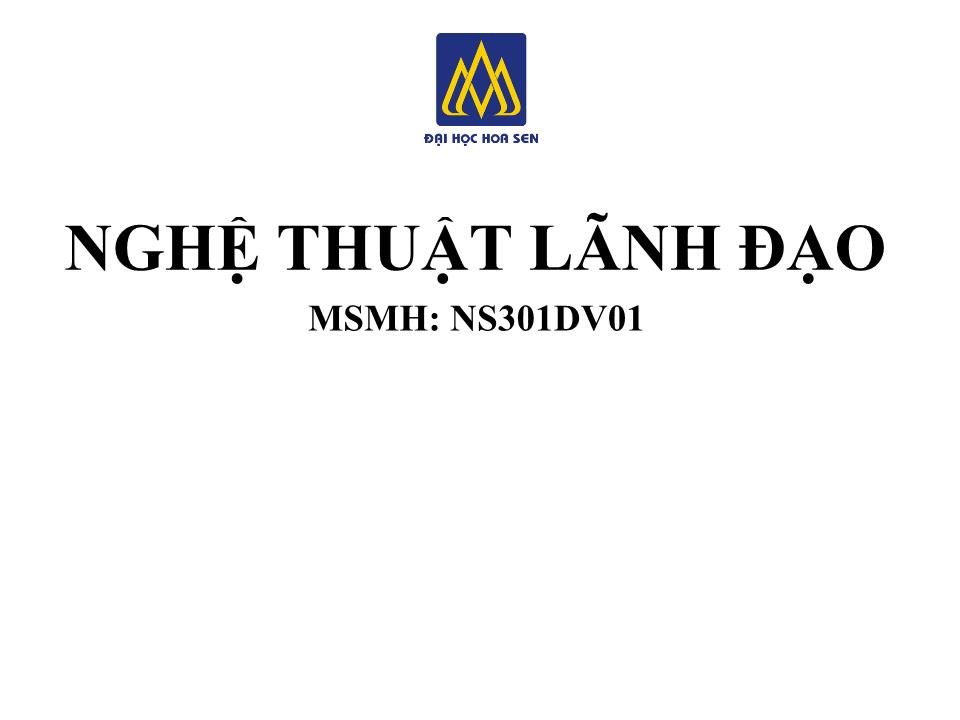
Trang 1
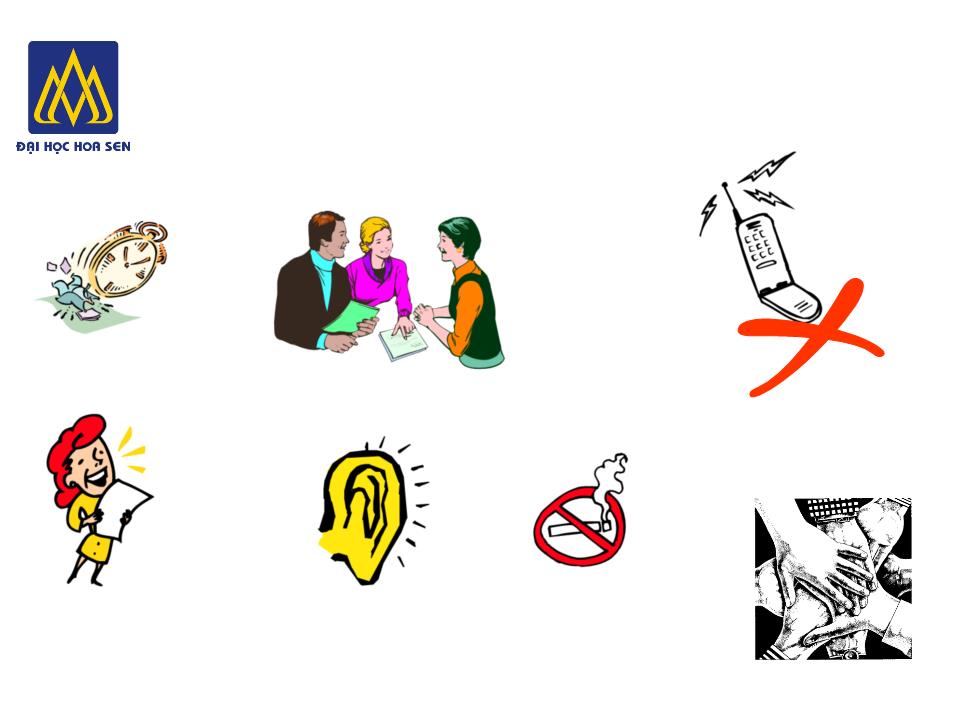
Trang 2
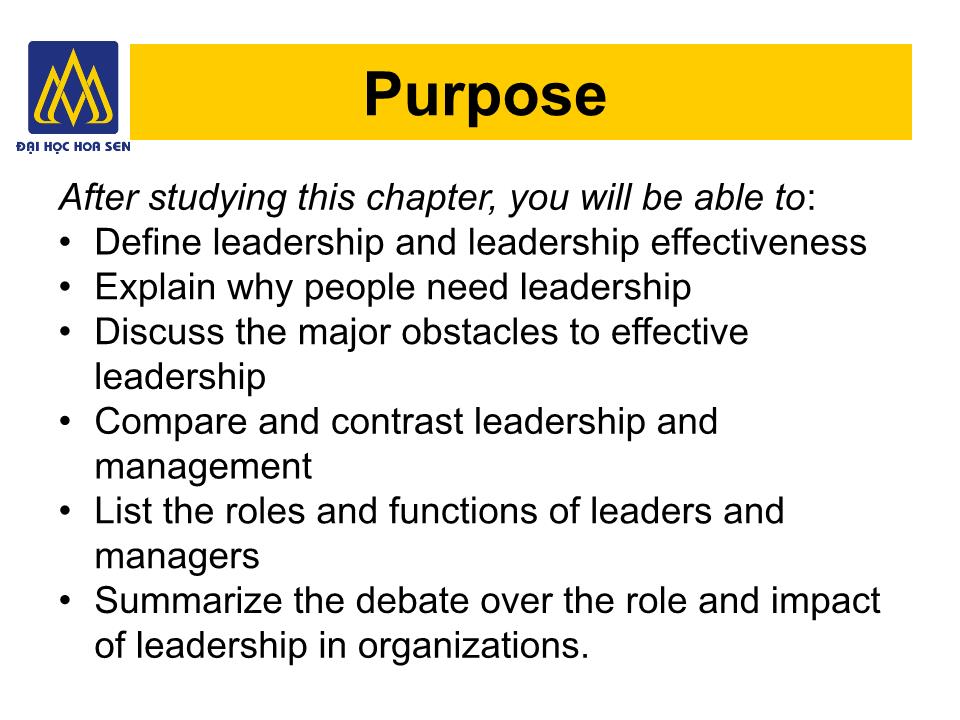
Trang 3
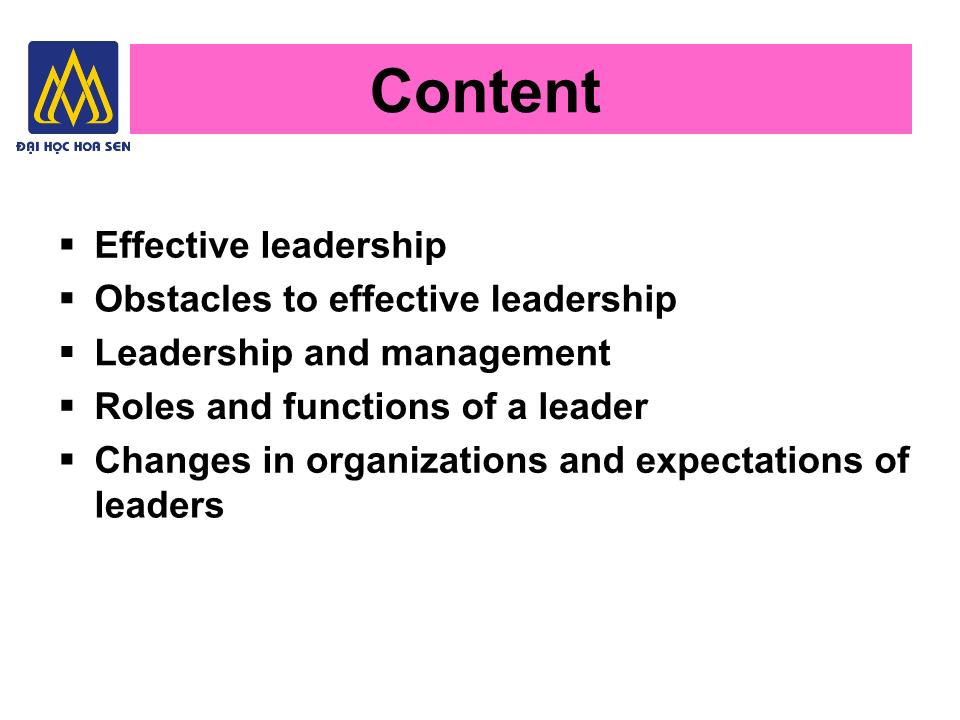
Trang 4
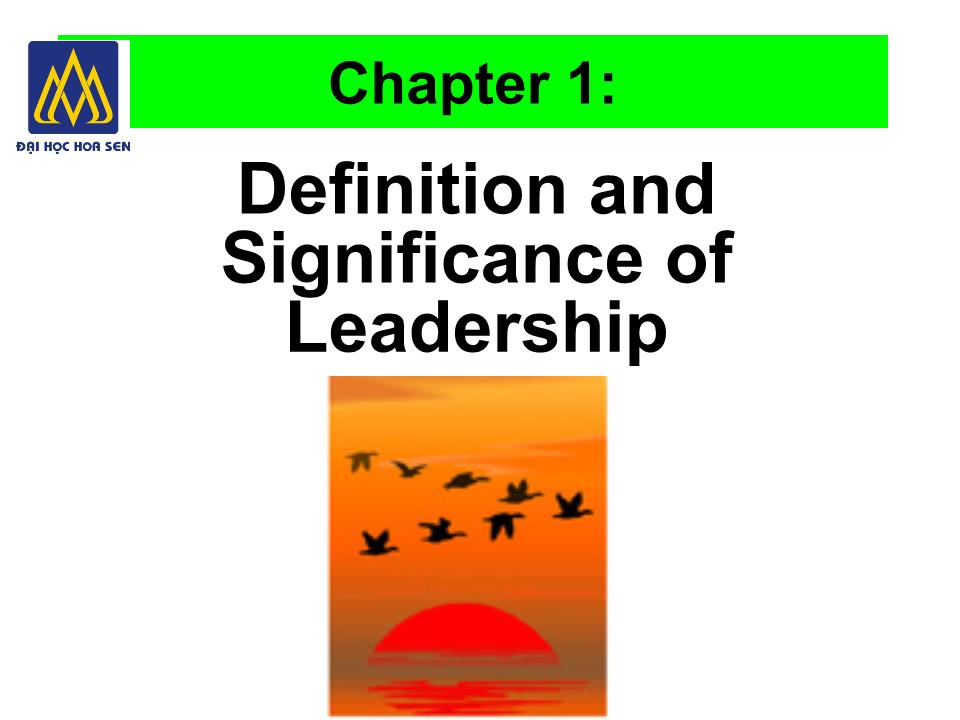
Trang 5
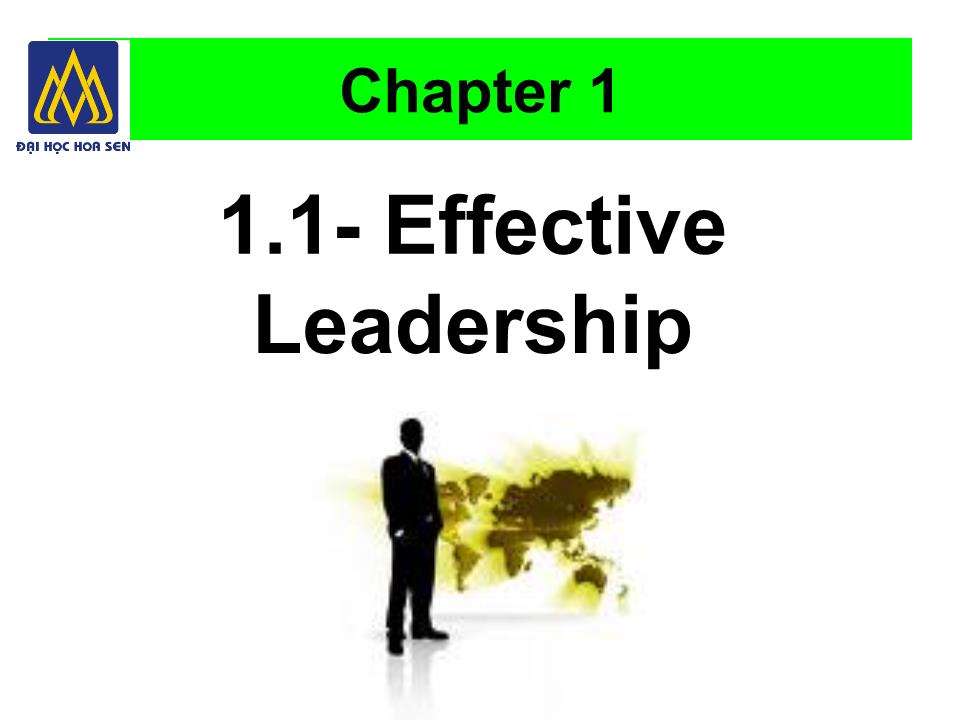
Trang 6
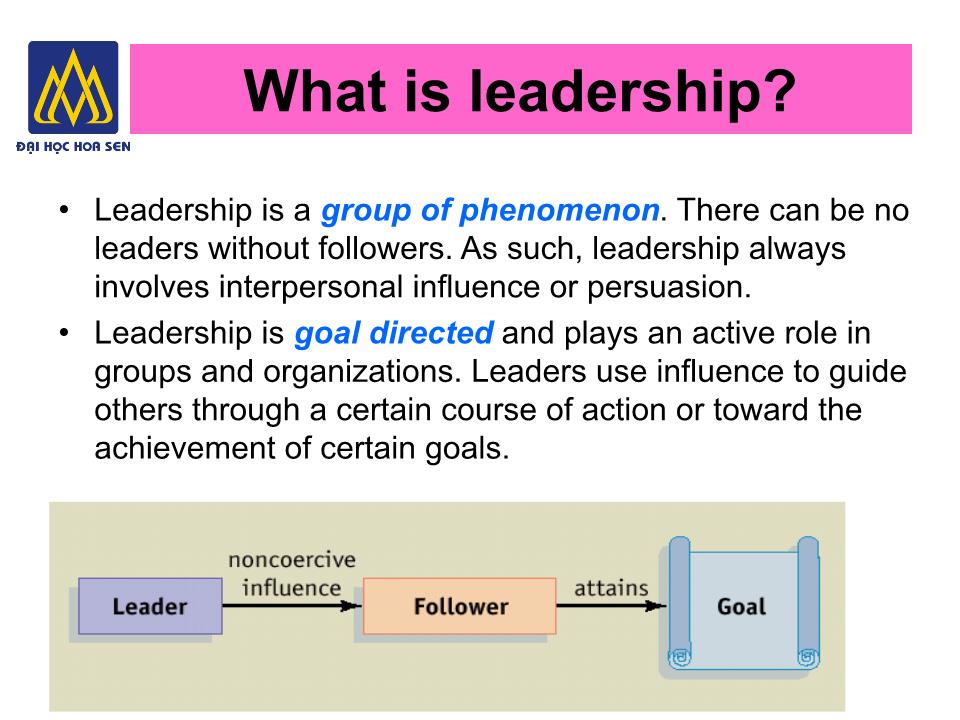
Trang 7
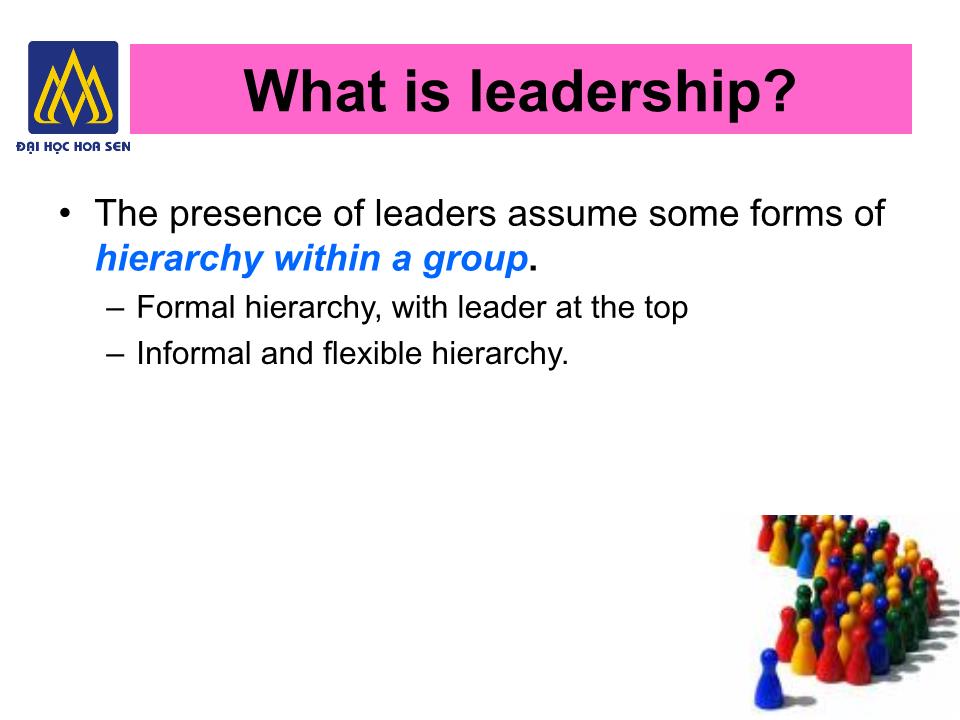
Trang 8
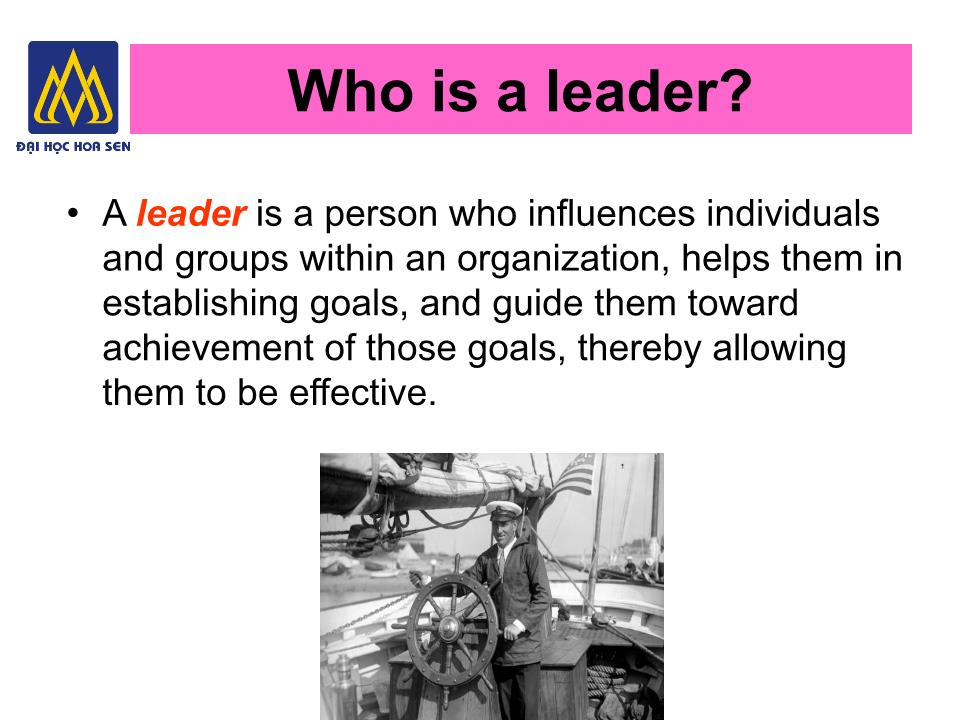
Trang 9
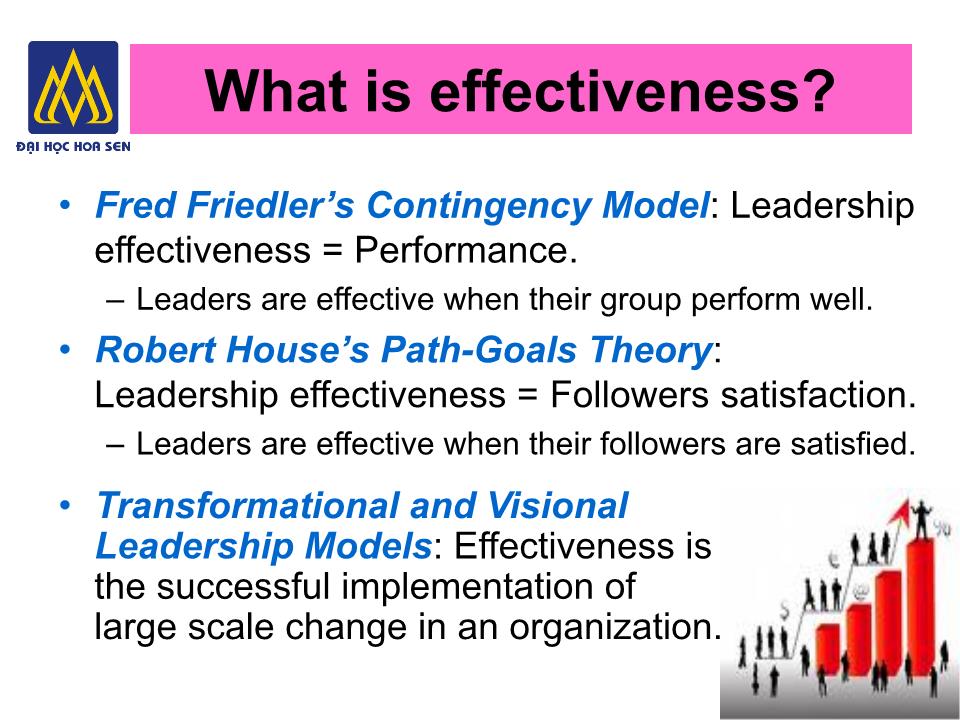
Trang 10
Tải về để xem bản đầy đủ
Bạn đang xem 10 trang mẫu của tài liệu "Bài giảng Nghệ thuật lãnh đạo - Chapter 1: Definition and Significance of Leadership", để tải tài liệu gốc về máy hãy click vào nút Download ở trên
Tóm tắt nội dung tài liệu: Bài giảng Nghệ thuật lãnh đạo - Chapter 1: Definition and Significance of Leadership
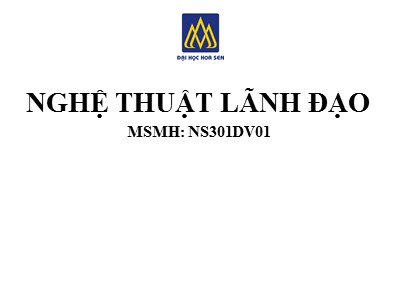
NGHỆ THUẬT LÃNH ĐẠO MSMH: NS301DV01 Purpose After studying this chapter, you will be able to : Define leadership and leadership effectiveness Explain why people need leadership Discuss the major obstacles to effective leadership Compare and contrast leadership and management List the roles and functions of leaders and managers Summarize the debate over the role and impact of leadership in organizations. Content Effective leadership Obstacles to effective leadership Leadership and management Roles and functions of a leader Changes in organizations and expectations of leaders Chapter 1: Definition and Significance of Leadership Chapter 1 1.1- Effective Leadership What is leadership? Leadership is a group of phenomenon . There can be no leaders without followers. As such, leadership always involves interpersonal influence or persuasion. Leadership is goal directed and plays an active role in groups and organizations. Leaders use influence to guide others through a certain course of action or toward the achievement of certain goals. What is leadership? The presence of leaders assume some forms of hierarchy within a group . Formal hierarchy, with leader at the top Informal and flexible hierarchy. Who is a leader? A leader is a person who influences individuals and groups within an organization, helps them in establishing goals, and guide them toward achievement of those goals, thereby allowing them to be effective. What is effectiveness? Fred Friedler’s Contingency Model : Leadership effectiveness = Performance . Leaders are effective when their group perform well. Robert House’s Path-Goals Theory : Leadership effectiveness = Followers satisfaction. Leaders are effective when their followers are satisfied. Transformational and Visional Leadership Models : Effectiveness is the successful implementation of large scale change in an organization. What is effectiveness? Community point of view : “Effectiveness is helping people communicate more, collaborate more, and innovate more” (Mieszkowski, 1998) “Cooperation, aligning people’ self-interest, and getting buy-in from the people who are affected by the leader’s decisions” (Baker, 2006) “Helping the community, and bring self-sufficient” (Salter, 2000a) Sales point of view : Satisfied customer. Effectiveness can only be achieved by providing “attentive, sincere, memorable service” (McGregor, 2004a: 83) What is effectiveness? 1. The definitions of leadership effectiveness are as diverse as the definitions of organizational effectiveness. The choice of a certain definition depends mostly on the point of view of the person trying to determine effectiveness , and on the constituents who are being considered . What is effectiveness? 2. Fred Luthans (1989 ): defines leadership effectiveness by distinguishing between effective and successful managers. Effective Managers Successful Managers Those with satisfied and productive employees Those who are promoted quickly Spend their time communicating with subordinates, managing conflicts, and training, developing and motivating employees Focus not on employees. Instead, they concentrate on networking activities such as interacting with outsiders, socializing and politicking. What is effectiveness? 3. Any definition of leadership effectiveness should consider all different roles and functions that a leader performs. In fact, organizations often fall back on simplistic measures, regardless of how satisfied the company’s employees are. Stockholders and financials consider a CEO to be effective if company stock prices keep increasing. Politicians are effective if the polls indicate their popularity is high and if they are reelected. A football coach is effective when the team is winning. Students’ scores on standardized tests determine a school principal’s effectiveness. What is effectiveness? The common thread in all these examples of effectiveness is the focus on outcome . To judge their effectiveness, we look at the results of what leaders accomplish. Process issues, such as employees’ satisfaction, are important but are rarely the primary indicator of effectiveness. What is effectiveness? The definition of leadership effectiveness, therefore, should contain 3 elements: Goals achievement : meeting financial goals, producing quality products or services, addressing the needs of customers Smooth internal process : group cohesion, followers’ satisfaction, and efficient operations. External adaptability : group’s ability to change and evolve successfully When is a leader effective? Leaders are effective when their followers achieve their goals, can function well together, and can adapt to changing demands from external forces. Why do we need leaders? To keep group orderly and focused . The existence of groups require some form of organization and hierarchy. Leaders are needed to pull the individuals together, organize and coordinate their efforts. To accomplish tasks . Groups allow us to accomplish tasks that individuals alone could not undertake or complete. Leaders are needed to facilitate that accomplishment, to provide goals and directions, and coordinate activities. To make sense of the world . Groups and their leaders provide individuals with a perceptual check. Leaders help us make sense of the world, establish social reality, and assign meaning to events and situations that may be ambiguous. To be romantic ideals . Leadership is needed to fulfill our desire for mythical or romantic figures who represent us and symbolize our own and our culture’s ideals and accomplishments. Chapter 1 1.2- Obstacles to Effective Leadership Obstacles To Effective Leadership Organizations face considerable uncertainty that creates pressure for quick responses and solutions. Implementing new methods of leadership would make dealing with complexity and uncertainty easier in the long run. The lack of learning and experimentation causes the continuation of the crises, which makes unavailable the time needed to learn and practice innovative behaviors. Organizations are often rigid and unforgiving . In the push for short-term and immediate performance, organizations do not allow any room for mistake and experimentation. Such rigidity and reward systems discourage endeavors. Obstacles To Effective Leadership Organizations fall back on old ideas about effective leadership, and therefore, rely on simplistic solutions that do not fit new and complex problems. Organizations develop a particular culture that strongly influences how things are done and what is considered acceptable behavior. As leaders try to implement new ideas and experiment with new methods, they may face resistance generated by the established culture. The difficulty involved in understanding and applying the findings of academic research . Chapter 1 1.3- Leadership and Management Leadership and Management Leadership and Management Managers Leaders Focus on the present Maintain status quo and stability Implement policies and procedures Maintain existing structure Remain aloof to maintain objectivity Use position power Focus on the future Create change Initiate goals and strategies Create a culture based on shared values Establish an emotional link with followers Use personal power Chapter 1 1.4- Roles and Functions of a Leader Managerial Roles Roles : are sets of expected behaviors ascribed to leaders/ managers by virtue of their leadership position. Basic managerial functions : planning, organizing, staffing, directing and controlling Internal functions : to provide their groups or organizations with a sense of vision and mission Department managers need to plan and organize their department’s activities and assign various people to perform tasks, monitor their employees’ performance and correct employee's actions when needed. Strategic and external functions. Managers negotiate with their boss and other department managers for resources and coordinate decisions and activities with them. Additionally, they must participate in strategic planning and the development of their own mission. Functions of the leader One of the major functions of leaders is the creation and development of a culture and climate for their groups or organizations (Nahavandi and Malekzadeh, 1993a; Schein, 2004). Functions of the leader Leaders are models for other organizational members. They establish and grant the status symbols that are the main artifacts of organizational culture. Followers take their cues from the leaders on what behaviors are and are not acceptable. Leaders are to manage the emotions of group members (Hemphrey, 2002; Kellett, Humphrey, and Sleeth, 2002) to maintaining followers' positive outlook in uncertain and ambiguous situations. Followers observe their leaders’ emotional reactions and take their cues from them to determine appropriate reactions (Pescosolido, 2002): teamwork, globalization, challenge to retain valued employees. Functions of the leader Leaders, particularly founders, leave an almost-indelible mark on the assumptions that are passed down from one generation to the next. In fact, organizations often come to mirror their founders’ personalities. Founders’ style (or founders’ family history): If the founder is workaholic and control oriented , the organization is likely to push for fast-paced decision making and be centralized. If the founder is participative and team oriented , the organization will be decentralized. Functions of the leader Leaders are to accept responsibility for one’s action . With the power and status afforded to leaders, comes the obligation of accepting responsibility for their own decisions and the organization's impact on others. Leaders are to make decisions regarding the reward system (Kerr and Slocum, 1987) and the control over decision standards. Rewards: financial and non financial Accomplishments: contribution to cultural diversity or the degree of social responsibility. Leaders are in charge of selecting other leaders and managers for the organizations . Those selected are likely to fit the existing leader’s ideal model and, therefore, fit the culture. Functions of the leader Leaders are to make decisions for the organization about structure and strategy , by determining the hierarchy, span of control, reporting relationship, and degree of formularization and specialization. A highly decentralized and organic structure open and participative culture A highly centralized structure mechanistic/ bureaucratic culture. The structure of an organization limits or encourage interaction, and by doing so, affects the assumptions shared by members of the organizations. The strategy selected by the leaders or top management team will be determined by the culture of the organization. A proactive growth strategy that require innovation and risk taking vs.. a strategy of retrenchment . Does Leadership Make a Difference Leadership is Insignificant Leadership has an Impact Outside environmental factors affect organizations more than leadership Internal structure and strategy determine the course an organization takes Leadership accounts for only 7 to 15% of financial performance Leaders have little discretion to really make an impact Leadership is a romantic myth rather a real organizational factor Leadership is one of the many important factors Leadership is key in providing vision and direction Leadership can account for up to 44% of a firm’s profitability Leadership is critical in orchestrating change Leadership’s impact is moderated by situational factors Reconciling the Differences Leadership is one of many factors that influence the performance of a group or an organization. The leader's contribution , although not always tangible, is often significant in providing a vision and direction for followers and in integrating their activities. About the leader's power and discretion , the key is to identify situations where the leader's power and discretion over the group and organization are limited. The potential lack of impact of leaders in some situations further emphasizes the importance of followers in the success of leadership and the need to understand organizations as broad systems. The 2 views (against and for the impact of leadership) complement each other and should be fully integrated (Osborn, Hunt, and Jauch, 2002). Chapter 1 1.5- Changes in Organizations and Expectations of Leaders Control versus Result-Oriented Leadership Roles of leaders in organizations Traditional Model New Model Control of group Initiation-of-structure skills Responsible only for production; the planning, leading and controlling functions, as well as the responsibility for results, fall on the manager. Facilitation and participation skills Managers are expected to provide the vision, get the needed resources to employees, account as support person, and get out of employees' way. Employees learn about the strategic and financial issues related to their job, plan their own activities, set production goals, and take responsibility for their result. Factors fueling changes External and internal organizational factors are driving the changes in organizations and in the role of leaders and managers. Political changes worldwide more openness and democracy. Global and local competition , and complex and fast changing technologies reconsider how to provide goods and services to customers Global competition associated with consumer demands for improved quality in products and services need for flexibility and creativity on the part of organizations Factors fueling changes Demographic changes increased diversity (age, gender, ethnic background, women in the workforce) in groups and organizations leaders must consider this diversity when making decisions younger generation enters the workplace with expectation of participation and autonomy, fast promotions, challenging learning opportunities, training, and work life balance Increase in service jobs (vs. traditional manufacturing jobs) employees be in direct contact with customers, use judgment and make quick decisions (that previously reserved for management) Barriers to Change Autocratic leaders whose goals are clearly, not employee motivation and loyalty. Cost-cutting strategies widespread layoffs. Focus on short-term and quick results cannot create the motivation necessary for the innovation and superior service. Top management still remains a one-person show . Old cultures in the reward system (for individual performance), more bureaucracy, lower autonomy, low responsibility. Employees are not willing or able to accept their new roles as partners and decision makers, even when such roles are offered to them. Even when organizations encourage change, leaders find giving up control difficulty (because of years of traditional training, of personality characteristics) Questions ?
File đính kèm:
 bai_giang_nghe_thuat_lanh_dao_chapter_1_definition_and_signi.ppt
bai_giang_nghe_thuat_lanh_dao_chapter_1_definition_and_signi.ppt

